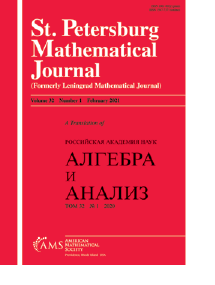On minimal Leibniz algebras with nilpotent commutator subalgebra
HTML articles powered by AMS MathViewer
- by
S. M. Ratseev
Translated by: V. A. Vavilov - St. Petersburg Math. J. 27 (2016), 125-136
- DOI: https://doi.org/10.1090/spmj/1379
- Published electronically: December 7, 2015
- PDF | Request permission
Abstract:
Let $\{c_n({\mathbf V})\}_{n\geq 1}$ be the codimension sequence of a variety of Leibniz algebras ${\mathbf V}$. The complexity function $\mathcal {C}({\mathbf V},z)=\sum _{n=1}^{\infty }c_n({\mathbf V})z^n/n!$ is studied. This is an exponential generating function for the codimension sequence. Before, complexity functions were used to study Lie algebras and associative algebras. In this paper, an explicit formula is obtained for the complexity function of a variety of Leibniz algebras with nilpotent commutator subalgebra, specifically, the variety determined by the identity $x_0(x_1x_2)(x_3x_4)\dots (x_{2s-1}x_{2s})=0$. By using this function, an explicit formula is derived for the codimensions of these algebras, which grow exponentially. Also, two series of varieties of Leibniz algebras with nilpotent commutator subalgebra of polynomial growth are constructed; they are minimal in a certain sense. Namely, the codimension sequence of any variety in the first of these series grows as a polynomial of a certain degree $k$, but for all its proper subvarieties the codimension sequence grows as a polynomial of some degree strictly smaller than $k$. The codimension sequence of any variety of the second series grows as a polynomial with some value of the leading coefficient $q$, whereas for all its proper subvarieties the codimension sequence grows as a polynomial whose leading coefficient is strictly smaller than $q$.References
- A. Bloh, On a generalization of the concept of Lie algebra, Dokl. Akad. Nauk SSSR 165 (1965), 471–473 (Russian). MR 0193114
- Jean-Louis Loday and Daniel Quillen, Cyclic homology and the Lie algebra homology of matrices, Comment. Math. Helv. 59 (1984), no. 4, 569–591. MR 780077, DOI 10.1007/BF02566367
- Jean-Louis Loday, Une version non commutative des algèbres de Lie: les algèbres de Leibniz, Enseign. Math. (2) 39 (1993), no. 3-4, 269–293 (French). MR 1252069
- Yu. A. Bahturin, Identical relations in Lie algebras, VNU Science Press, b.v., Utrecht, 1987. Translated from the Russian by Bahturin. MR 886063
- I. P. Goulden and D. M. Jackson, Combinatorial enumeration, Wiley-Interscience Series in Discrete Mathematics, John Wiley & Sons, Inc., New York, 1983. With a foreword by Gian-Carlo Rota. MR 702512
- V. M. Petrogradskiĭ, On types of superexponential growth of identities in Lie PI-algebras, Fundam. Prikl. Mat. 1 (1995), no. 4, 989–1007 (Russian, with English and Russian summaries). MR 1791624
- V. M. Petrogradskiĭ, Growth of polynilpotent varieties of Lie algebras, and rapidly increasing entire functions, Mat. Sb. 188 (1997), no. 6, 119–138 (Russian, with Russian summary); English transl., Sb. Math. 188 (1997), no. 6, 913–931. MR 1479133, DOI 10.1070/SM1997v188n06ABEH000232
- S. M. Ratseev, The growth of some varieties of Leibniz algebras, Vestn. Samar. Gos. Univ. Estestvennonauchn. Ser. 6 (2006), 70–77 (Russian, with English and Russian summaries). MR 2296193
- S. Mishchenko and A. Valenti, A Leibniz variety with almost polynomial growth, J. Pure Appl. Algebra 202 (2005), no. 1-3, 82–101. MR 2163402, DOI 10.1016/j.jpaa.2005.01.013
- S. M. Ratseev, On the growth of associative and Leibniz algebras, Vestn. Samar. Gos. Univ. Estestvennonauchn. Ser. 2008, no. 6, 177–184. (Russian)
- Ronald L. Graham, Donald E. Knuth, and Oren Patashnik, Concrete mathematics, 2nd ed., Addison-Wesley Publishing Company, Reading, MA, 1994. A foundation for computer science. MR 1397498
- L. E. Abanina and S. M. Ratseev, A variety of Leibniz algebras associated with standard identities, Vestn. Samar. Gos. Univ. Estestvennonauchn. Ser. 6 (2005), 36–50 (Russian, with English and Russian summaries). MR 2232881
- A. Giambruno, D. La Mattina, and V. M. Petrogradsky, Matrix algebras of polynomial codimension growth, Israel J. Math. 158 (2007), 367–378. MR 2342471, DOI 10.1007/s11856-007-0017-7
- Daniela La Mattina, Varieties of almost polynomial growth: classifying their subvarieties, Manuscripta Math. 123 (2007), no. 2, 185–203. MR 2306632, DOI 10.1007/s00229-007-0091-5
Bibliographic Information
- S. M. Ratseev
- Affiliation: Ulyanovsk State University, 42 Lev Tolstoy str., 432017 Ulyanovsk, Russia
- Email: ratseevsm@mail.ru
- Received by editor(s): June 2, 2014
- Published electronically: December 7, 2015
- © Copyright 2015 American Mathematical Society
- Journal: St. Petersburg Math. J. 27 (2016), 125-136
- MSC (2010): Primary 17A32
- DOI: https://doi.org/10.1090/spmj/1379
- MathSciNet review: 3443269


